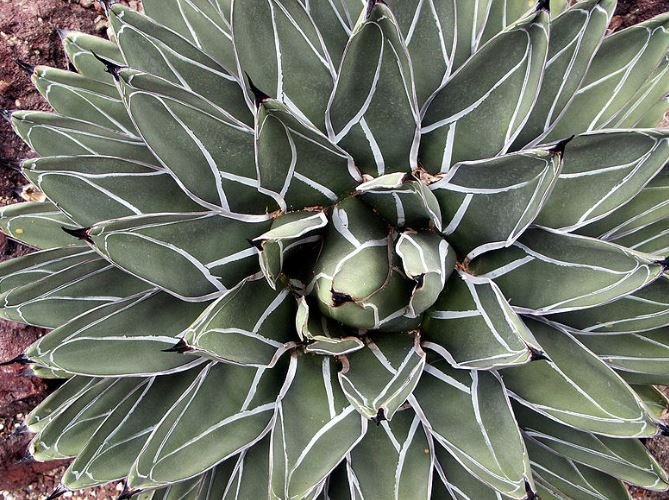The Agavaceae, form a subfamily of monocotyledonous plants distributed more or less throughout the world and especially diverse in Mexico.
The family of the Agavaceae is endemic to America, there are 210 species of Agave, of which 159 in Mexico, and includes nine genera and about 300 species. They are called, Maguey.
The Agaves grow in the plains, the mountains, the cliffs, the coastal dunes or in the mountain peaks.
Present in tropical, subtropical and temperate zones, preferably at more than 1,000 meters of altitude.
The genus Agave , gives name to the family Agavaceae.
However, only fermented or distilled beverages are obtained from the Agave genus , for example, it is used to make tequila and mezcal.
These American plants are plants with rhizomes or woody stems succulent leaves, this is elongated leaves, coriaceous, fibrous and more or less fleshy.
Arranged in a spiral around a short stem on whose edges are marginal spines and a terminal at the apex.
Flowers usually hermaphrodites. Berry type fruits.
Table of Contents
Types of Agavaceae

Agave

What uses do the Agavaceae have?
The Agave has always been used, since long before the pre-Hispanic era, to extract the sweet sap of the plant known as aguamiel.
The mead is a beverage having a very low percentage of alcohol and the pulque, resulting from the natural fermentation of mead slightly alcoholic beverage.
Likewise, it is used for the production of different types of distilled alcoholic beverages, with high alcohol content, such as tequila.
Of the nine genera of Agave, benefits are obtained, since it has important economic uses such as fibers, food, construction material, soap substitutes, among other products.
The industrial species, Agave sisalana or sisal, American Agave or pita, both for obtaining fibers.
Pita is also used to make fermented beverages.
Ornamental species, American Agave, pita and Yucca.
In Mexico, authentic ancestral connoisseurs of the properties of the Agaves, these plants have very definite uses.
More in detail such as, traditional uses that include the consumption of floral escapes as human food.
Equally, the use of the same, along with the leaves for the construction, the elaboration of daily utensils, honeycombs for bees and like domestic fuel.
The fibers of the leaves are used in yarns for fabrics, hammocks and packaging.
Especially of the henequen (Agave fourcroydes and Agave sisalana) or the fiber of Agave inaequidens, unique in its kind, to produce ropes and cords.
Pencas are used as tiles in roofs, plants as fences or fences in a row, drums are made from the rooted log.
Also, there is a record of its use to produce steroids, cosmetology products and soap.
Other uses.
In addition to these important traditional uses, in recent times other novelties are being extended.
Among others stand out, the production of honeys and syrups indicated for diabetics and inulin.
Inulin, this is a natural extract of the root of some plants and is part of the group of oligosaccharides, with the composition of a long-chain carbohydrate.
It is part of the dietary fiber and its incorporation into the daily diet is of great importance, as it reaches the intestine almost undigested, which increases the development of bifid bacteria.
Growing tips of the Agavaceae
Regarding lighting, most agavaceans are exposed to a lot of sun and heat all day, but there are also species that prefer darker places.
In this case it is better to keep them in greenhouses. The Agavaceae withstand high temperatures well, but they appreciate semi-shade.
The Agavaceae, prefer a dry and warm aeration.
If they remain without a continuous breeze and high humidity, they can be very affected, even dying if the conditions persist.
For this reason they can die because of fungi, which cause stem and / or root rot.
These effects of moisture and poor aeration can attract the cottony cochineal, which can multiply easily in this environment.
Regarding watering , it should be spaced in spring and summer and almost sporadic or null in winter.
Always let the substrate dry before re-watering.
To keep the plant healthy and in shape, the garden substrate will be a mixture of 50% garden soil and 50% granite sand.
With this, we will facilitate the drainage of surplus water.
As for fertilizer , we will be sparse, the most suitable for these succulents, is a mixture of 10% Nitrogen, 20% Phosphorus, 20% Potassium.
This nutritional additive is used only twice a year.
The plagues that the family of the Agavaceae can support, are basically the cottony scale and the fungi, due to excess humidity.
Most known and recognized species of agavaceae.
A. Coloratha

;
A. Guiengola
A. Macroacantha

A. Nizandensis

A. Polianthiflora

A. Seemanniana var. Nana

A. Striata

A. Xylonacantha





